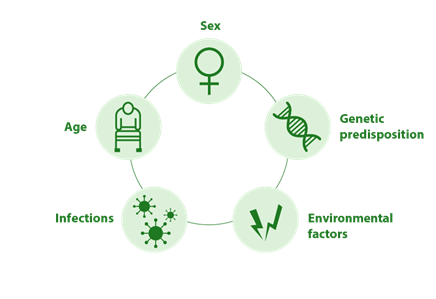Who is at increased risk of developing Giant Cell Arteritis?
Giant Cell Arteritis (GCA) – also known as Horton’s disease or colloquially as “rheumatism of the head” – primarily affects people over the age of 50. One striking feature is that women are significantly more likely to be affected than men. The exact cause of this chronic vascular inflammation remains unclear to this day. However, it is important to treat the disease at an early stage in order to prevent long-term complications. Some typical characteristics indicate who is particularly at risk in older age:
These are risk factors for Giant Cell Arteritis:
- Age: The risk of developing the disease increases significantly with age – particularly after the age of 50.
- Sex: Women are affected about three times more frequently than men.
- Genetic predisposition: Familial clustering and certain genetic markers suggest a hereditary component.
- Infections: Some viruses or bacteria may influence the immune system in such a way that it mistakenly attacks the body’s own blood vessels.
- Environmental factors: People living in urban areas appear to be affected more frequently than those in rural regions.
Do several risk factors apply to you? Then find out now about the warning signs and symptoms of the disease – the earlier it is detected, the better it can be treated!

These are risk factors for Giant Cell Arteritis: older age, female sex, genetic predisposition, infections, and environmental factors
Rheumatism of the head = rheumatism in the joints?
More than half of those affected by Giant Cell Arteritis also suffer from Polymyalgia rheumatica (PMR) – an inflammatory rheumatic disease. In many cases, it precedes Giant Cell Arteritis or occurs simultaneously. When PMR is diagnosed, special attention should be paid to possible warning signs of “rheumatism on the head.”
Warning signs of Polymyalgia rheumatica – how does the disease manifest?
PMR primarily manifests through:
- Sudden onset of severe pain in the shoulders, neck, upper arms, and hips
- Morning joint stiffness
- Severe fatigue, fever, and weight loss
Why is the diagnosis of polymyalgia rheumatica so important for Giant Cell Arteritis?
If muscle and limb pain, stiff joints, and additional headaches occur together with headaches or visual disturbances, it is essential to have a medical evaluation to determine whether an autoimmune disease such as Giant Cell Arteritis is the cause – especially in people over 50. The reason: if this chronic vascular inflammation is not detected and treated early, permanent damage may occur. Learn more here about the symptoms of Giant Cell Arteritis, diagnostic options, and treatment possibilities!
